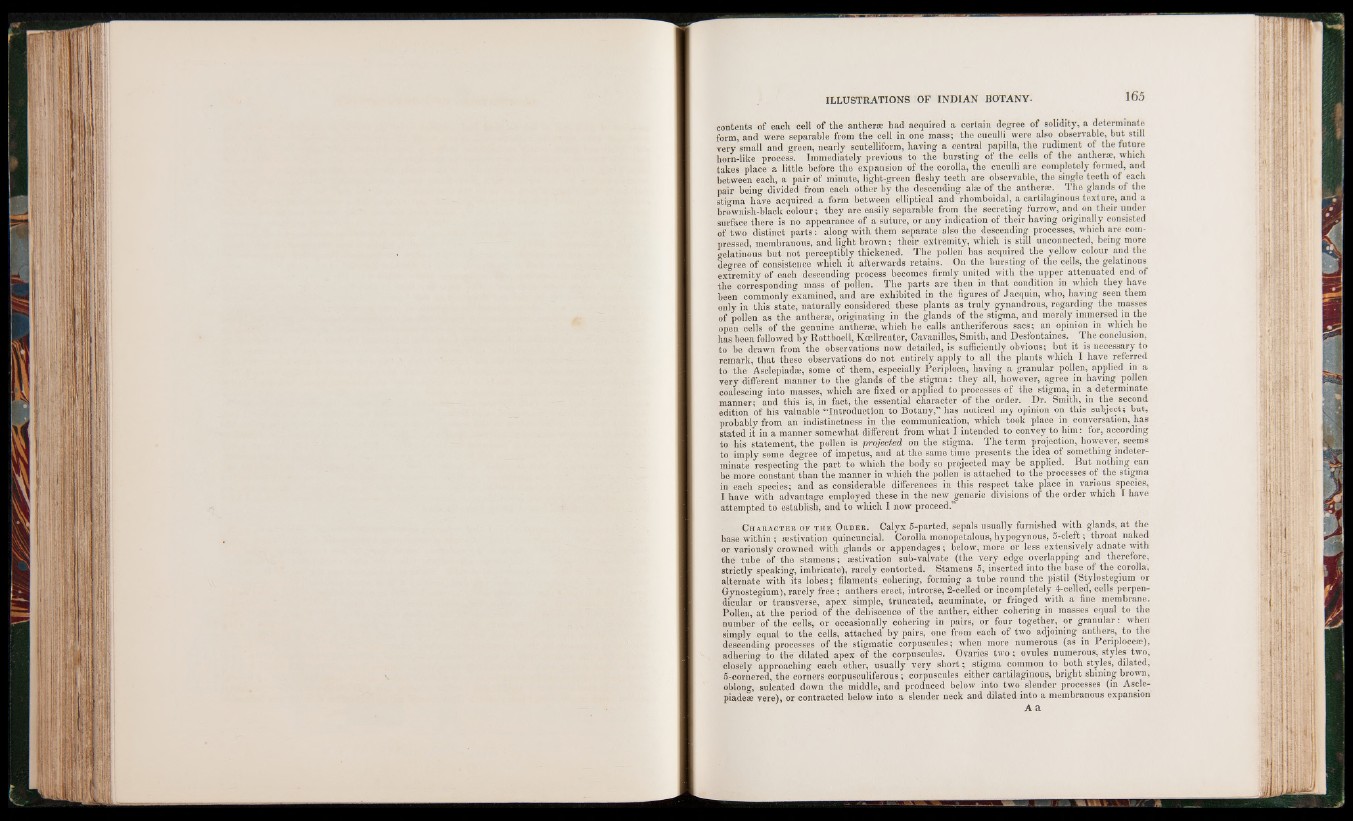
IL L U ST R A T IO N S O F IN D IA N B O T A N Y .
contents of each cell of the antherce had acquired a certain degree of solidity, a determinate
form, and were separable from the cell in one mass; the cuculti were also observable, but still
very small and green, nearly scutelliform, having a central papilla, the rudiment of the future
horn-like process. Immediately previous to the bursting of the cells of the antherae, which
takes place a little before the expansion of the corolla, the cuculli are completely formed, and
between each, a pair of minute, light-green fleshy teeth are observable, the single teeth of each
pair being divided from each other by the descending ala; of the antherae. The glands of the
stigma have acquired a form between elliptical and rhomboidal, a cartilaginous texture, and a
brownish-black colour; they are easily separable from the secreting furrow, and on their under
surface there is no appearance of a suture, or any indication of their having originally consisted
of two distinct parts: along with them separate also the descending processes, which are compressed,
membranous, and light brown; their extremity, which is still unconnected, being more
gelatinous but not perceptibly thickened. The pollen has acquired the yellow colour and the
degree of consistence which it afterwards retains. On the bursting of the cells, the gelatinous
extremity of each descending process becomes firmly united with the upper attenuated end of
the corresponding mass of pollen. The parts are then in that condition in which they have
been commonly examined, and are exhibited in the figures of Jacquin, who, haying seen them
only in this state, naturally considered these plants as truly gynandrous, regarding the masses
of pollen as the antherae, "originating in the glands of the stigma, and merely immersed in the
open cells of the genuine antherae, which he calls antheriferous sacs; an opinion in which he
has been followed by Rottboeli, Kcellreuler, Cavanilles, Smith, and Desfontaines. The conclusion,
to be drawn from the observations now detailed, is sufficiently obvious; but it is necessary to
remark, that these observations do not entirely apply to all the plants which I have referred
to the Asclepiadae, some of them, especially Periploca, having a granular pollen, applied in a
very different manner to the glands of the stigma: they all, however, agree in having pollen
coalescing into masses, which are fixed or applied to processes of the stigma, in a determinate
manner; and this is, in fact, the essential character of the order. Dr. Smith, in the second
edition of his valuable “Introduction to Botany,” has noticed my opinion on this subject; but,
probably from an indistinctness in the communication, which took place in conversation, has
stated it in a manner somewhat different from what I intended to convey to him: for, according
to his statement, the pollen is projected on the stigma. The term projection, however, seems
to imply some degree of impetus, and at the same time presents the idea of something indeterminate
respecting the part to which the body so projected may be applied. But nothing can
be more constant than the manner in which the pollen is attached to the processes of the stigma
in each species; and as considerable differences in this respect take place in various species,
I have with advantage employed these in the new generic divisions of the order which I have
attempted to establish, and to which I now proceed.”
Chaeacteh of the Obdek. Calyx 5-parted, sepals usually furnished with glands, at the
base within ; aestivation quincuncial. Corolla monopetalous, hypogynous, 5-cleft; throat naked
or variously crowned with glands" or appendages; below, more or less extensively adnate with
the tube of the stamens; sestivation sub-valvate (the very edge overlapping and therefore,
strictly speaking, imbricate), rarely contorted. Stamens 5, inserted into the base of the corolla,
alternate with its lobes; filaments^ cohering, forming a tube round the pistil (Stylostegium or
Gynostegium), rarely free ; anthers erect, introrse, 2-celled or incompletely 4-celled, cells perpendicular
or transverse, apex simple, truncated, acuminate, or fringed with a fine membrane.
Pollen, at the period of the dehiscence of the anther, either cohering in masses equal to the
number of the cells, or occasionally cohering in pairs, or four together, or granular: when
simply equal to the cells, attached by pairs, one from each of two adjoining anthers, to the
descending processes of the stigmatic corpuscules; when more numerous (as in Periploceae),
adhering to the dilated apex of the corpuscules. Ovaries two; ovules numerous, styles two,
closely approaching each other, usually very short; stigma common to both styles, dilated,
5-cornered, the corners corpusculiferous; corpuscules either cartilaginous, bright shining brown,
oblong, sulcated down the middle, and produced below into two slender processes (in Ascle-
piadese vere), or contracted below into a slender neck and dilated into a membranous expansion
A a